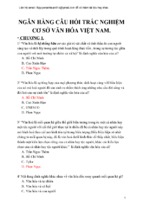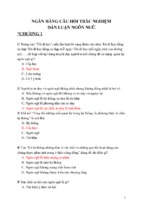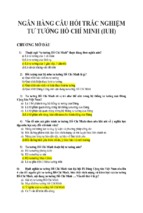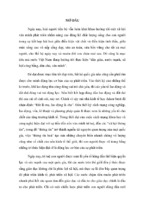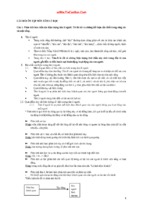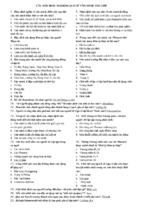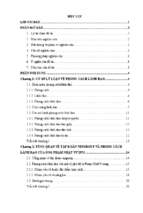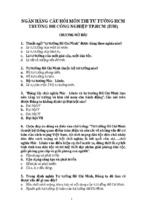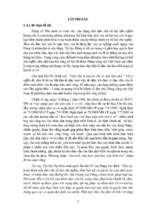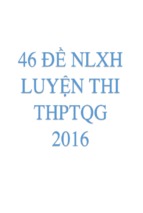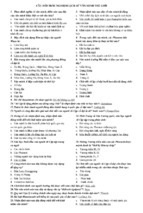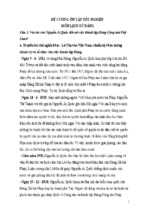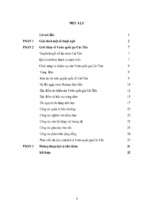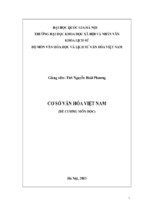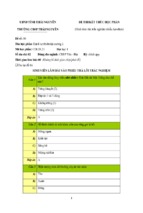MINISTRY OF EDUCATION AND TRAINING
CAN THO UNIVERSITY
SUMMARY OF THE THESIS
Major: Business administration
Code: 62340102
LE PHUOC HUONG
THE RELATIONSHIP BETWEEN
CORPORATE SOCIAL RESPONSIBILITY,
BRAND EQUITY AND FINANCIAL
PERFORMANCE OF JOINT-STOCK
COMMERCIAL BANKS
IN MEKONG DELTA
Can Tho, 2020
THE THESIS ARE COMPLETED AT
CAN THO UNIVERSITY
Supervisors:
- Luu Tien Thuan, Ph.D.
- Huynh Quang Linh, Ph.D.
The dissertation is defended in front of the doctoral thesis
committee at university level
Meeting at:
At ... hour ... day ... month ... year ...
PhD dissertation reviewer 1:
PhD dissertation reviewer 2:
The dissertation can be found at the library:
Learning Resource Center, Can Tho University.
Vietnam National Library.
LIST OF PUBLISHED ARTICLES
1.
Le Phuoc Huong, Luu Tien Thuan. 2017. Corporate social
responsibility - a literature review and future research directions.
Can Tho University Journal of Science. Vol 50. 19-33.
2.
Le Phuoc Huong, Luu Tien Thuan. 2017. Corporate social
responsibility of joint stock commercial banks: a study of some
dimensions. Journal Economics - Technology. Bình Dương
University. No19. 83-94.
3.
Le Phuoc Huong, Luu Tien Thuan. 2017. Corporate social
responsibility – A literature review and future research directions.
UHD-CTU Annual economics and business conference, 13-14/1/2017,
Can Tho University.
4.
Le Phuoc Huong, Luu Tien Thuan. 2018. Corporate Social
Responsibility in Banking. Banking Technology Review. 148. 48-67.
5. Le Phuoc Huong, Luu Tien Thuan. 2018. The effects of Corporate
social responsibility on brand equity and financial performance:
The case of commercial banks in Mekong Delta. Proceedings of
National Scientific Workshop: Economic and business development in
Vietnam in the context of globalization. Can Tho University. 414 –
437.
6. Le Phuoc Huong, Luu Tien Thuan and Nguyen Hai Trung. 2018.
Impacts of social responsibilities to the awareness of bank
employees in the Mekong Delta. Review of Regional Sustainable
Development. 8/3. 105-115.
7. Le Phuoc Huong, Luu Tien Thuan and Hua Ngoc Le. 2019. Corporate
social responsibility and customer loyalty: case of joint-stock
commercial banks. Journal Economics - Technology. Bình Dương
University. No 26. 46-56.
8. Le Phuoc Huong, Luu Tien Thuan. 2019. The impact of corporate
social responsibility and brand equity on financial performance:
The case of banking employees. Journal of Science Ho Chi Minh
City Open University. Vol 14. 41-53.
9. Le Phuoc Huong, Luu Tien Thuan. 2019. The relationship between
corporate social responsibility, brand equity and financial
performance: The case of commercial banks in Mekong Delta.
Can Tho University Journal of Science. Vol 55. 85-94.
10. Le Phuoc Huong, Luu Tien Thuan. 2019. The impact of corporate
social responsibility on financial performance: Case of Vietnam
joint stock commercial banks. Banking Science & Training Review.
Vol 211. 12-24.
1
CHAPTER 1: INTRODUCTION
1.1 BACKGROUND
Banking institutions have played an important role in connecting the
economy and pioneering the implementation of global trends such as
corporate social responsibility (CSR). Commercial banks are trying to
exploit the positive aspects of CSR’s activities to maximize the benefits
associated with increasing brand equity and financial performance (Saeidi
et al., 2015). Some managers believe that CSR is simply charity work
while CSR includes internal factors, other managers think that barrier of
implementing CSR’s practices is due to lack of human resources,
financial resources and implementation techniques (Nguyen Dinh Tai,
2010). According to Sprinkle and Maines (2010), any organizations must
pay attention to its impacts on environment and social security. Although
understanding social needs, banks or enterprises can hardly give up their
goal of maximizing profits (Sprinkle & Maines, 2010). Therefore, the
harmony between CSR’s activities and financial performance, that is good
for society and benefits for organizations are absolutely legitimate and
necessary.
According to Fatma et al. (2016a), each industry needs reliable
measurement tools for evaluating stakeholders’ perpection. In addition,
few CSR’s studies in the Asian context (Chapple & Moon, 2005; Fatma et
al., 2014). Compared to other industries, banking industry is effected by
brand, reputations and negative information about reputation that will lead
to negative actions of stakeholders (Thompson & Cowton, 2004). Retail
banks spent a lot of money on CSR’s programs to strengthen brands
(McDonald & Rundle-Thiele, 2008). The importance of brand equity in
the service sectors is crucial because their products and services are
intangible, so the trust of stakeholders is needed (Pérez et al., 2013). In
the context of restructuring Vietnamese banking system, in order to
enhancing brand equity and financial performance through CSR’s
programs of JSBs in Mekong Delta, the issues to be addressed are
measuring the impacts of CSR’s perception of customers, employees and
managers. From the above reasons, the study "The relationship between
corporate social responsibility, brand equity and financial performance
of joint-stock commercial banks in Mekong Delta" is a controversial
topic.
2
1.2 THE PURPOSE OF THIS STUDY
(1) To measure the impact of CSR’s perception on financial performance
of joint stock commercial banks.
(2) To measure the impact of CSR’s perception on brand equity of joint
stock commercial banks.
(3) To measure the impact of CSR’s perception and brand equity on
financial performance of joint stck commercial banks.
(4) To propose some managerial implications for banking managers to
conduct effectively CSR’s practices for enhancing brand equity and
financial performance.
1.3 SCOPE OF STUDY
The study focus on joint-stock commercial banks operating at
Mekong Delta. Secondary data was collected from 2011-2018. Primary
data is collected by in-depth interviews of experts working in banking
industry and interviewing by questionnaires from January 2018 to August
2018. The object of this study is the relationship between corporate social
responsibility, brand equity and financial performance of commercial
banks. Interviewers are customers, employees and managers who are
currently working in joint-stock commercial banks.
1.4 THEORETICAL AND PRACTICAL CONTRIBUTIONS
Theoretical Contributions
The findings of this research contribute to the field of CSR, which
are meaningful for researchers, lecturers and managers, but also propose
directions for further researches on the interaction between CSR, brand
equity and financial performance. In particular, according to the
literature review, the author has not found any researches on the impact
of five perceived CSR’s dimensions and brand equity in two aspects:
customer-based brand equity and employee-based brand equity on
financial performance in banking industry. Therefore, this study
contributes to CSR perception and its academic marketing outcomes in
several ways: (1) contributing to supplement scientific knowledge to the
field of marketing and management, thereby enriching the sources of
references in the field of marketing and management. (2) constructing
and testing to the CSR’s scale for banking industry, customer-based
brand equity and employee-based brand equity, after verifying this
reliability can be used for the future research. In addition, this study is
3
one of the pioneering studies that determine the impact of CSR’s
dimensions, brand equity on financial performance by primary data and
quantitative research. (3) The findings propose many orientations for
further studies to construct more tests to generalize deeply about the
relationships of perceived CSR, brand equity and financial performance
in Vietnamese banking industry, and trying to apply the theoretical
framework. In addition, the process and methodology are considered as a
reference for future researches.
Practical contributions
The research results have practical contributions for banking industry
in Mekong Delta as well as Vietnam as follows: (1) Provide a scientific
basis for banking managers to decide on the implementation of CSR’s
activities and allocating resources on each dimensions to improve
financial performance and enhance brand equity for gaining competitive
advantage. (2) Provide evidences to show the difference between staffs
and managers, male and female customers in each CSR’s dimension. So
that, banking managers can apply suitable strategies for each group. (3)
Testing customer-based brand equity and employee-based brand equity
and (4) The findings of this research and managerial implications as a
meaningful reference for banking industry.
1.5 THE STRUCTURE OF THESIS
The thesis consists of 151 pages with 5 chapters as follows:
Introduction; Literature review and research model; Research design;
Results and discussion; Conclusions and managerial implications.
CHAPTER 2: LITERATURE REVIEW AND
RESEARCH MODEL
2.1 STAKEHOLDER THEORY
The term "stakeholders" first appeared in 1963 to present business
ethics (Freeman, 1984). Stakeholders are participants, influencing or
benefiting from CSR’s activities including shareholders/owners,
community, customers, partners and staffs. CSR’s practices should bring
the highest benefits to stakeholders. Wang et al. (2015) confirms the
theory of fulcrum to draw conclusions about CSR - financial performance
relationship. There are many theories used in CSR studies, but
stakeholder theory is still the most reasonable theory and popular choice.
According to stakeholder theory, organizations aim to balance the
4
expectations of all stakeholder groups through their activities. Managers
should consider and maintain the expectations of all stakeholder groups
when they make decisions to disclosure relevant CSR’s information.
Inheriting previous studies, this thesis also applies stakeholder theory to
approach CSR according to the dimensions of customers, employees,
community, shareholders, legal and ethical requirement. According to
Retolaza et al. (2009), the stakeholder theory is the most relevant theory
to study CSR in banking industry.
2.2 CORPORATE SOCIAL RESPONSIBILITY
The CSR’s definition of the European Commission (2001) is that
enterprises should integrate social and environmental concerns into their
business; interact with stakeholders on a voluntary basis. CSR is a broad
concept and is expressed in the view of individual researchers, depend on
the context of the study (Dahlsrud, 2008). Researching the relationship
between CSR, brand equity and financial performance, this thesis uses the
CSR’s definition of European Commission (2001) and Carroll (1979).
This concept covers the voluntary, social aspect, environmental aspect,
economic aspect, and stakeholders. According to Dahlsrud (2008), this
CSR’s definition has the highest Google search frequency among the 37
definitions studied. Currently, there is no legal document related to CSR
in Vietnamese banking industry.
2.3 BRAND EQUITY
Customer-based brand equity: There are many different views on
brand equity model, but Aaker’s model (1991) is often cited by most
academic researchers (Atilgan et al., 2005). According to Kayaman &
Arasli (2007), the brand equity components are closely related, in which
the higher perceived quality leads to the better brand awareness and
increased brand loyalty. Yoo & Donthu (2001) was implemented to
develop a scale for evaluating customer-based brand equity. The results
have developed and validated multi-dimensional customer-based brand
equity scales drawn from the concepts of Aaker and Keller’s brand equity.
Multi-step psychological tests proved that new brand equity scale is
reliable, valid, analytical and generalized across many cultures and
product categories including brand loyalty, perceived quality and brand
image. Similarly, in this study, the author contacted interviewers at
branches, should ignore brand awareness, customer-based brand equity
including brand loyalty, perceived quality and brand image.
5
Employee-based brand equity: be measured through some
dimensions are brand citizenship behaviour, employee satisfaction,
employee intention to stay and positive employee word-of-mouth (King &
Grace, 2010). Employee satisfaction is considered an important dimension
of employee-based brand equity and is related to employee engagement
(Boselie & van der Wiele, 2002) and active communication (Shinnar et
al., 2004). Brand citizenship behavior is the behavior of employees
according to standards consistent with the brand equity (Burmann &
Zeplin, 2005). Employee satisfaction is the level of employee satisfaction
received from their job and is the result of doing what they want and the
value of that job (King & Grace, 2010). The employee intention to stay is
the future intention of employees to continue their current work (Good et
al., 1996). Positive employee word-of-mouth is the level at which an
employee is willing to say positive things about the business and is ready
to introduce the business to others (King & Grace, 2010).
2.4 FINANCIAL PERFORMANCE
Financial performance can be assessed by many criterias. In this
study, the author uses the ratio of return on total assets (ROA) and return
on equity (ROE) to measure financial performance of joint-stock
commercial banks because two ratios are popular in studies such as
Boaventura et al. (2012), Robin et al. (2018) ... In addition, two ratios are
widely publicized by joint-stock commercial banks through audited
financial statements to confirm the truthfulness and reasonableness.
Moreover, ROE and ROA measures the income ratio, reflecting the actual
situation of banks in an accounting period, in order to see more clearly the
relationship between CSR, brand equity and financial performance.
2.5 LITERATURE REVIEW
Chomvilailuk & Butcher (2010) tested the positive impact of CSR
on brand preference and perceived quality Thailand banking industry.
Banking industry is considered to be the most competitive industry in
Brazil, Scharf & Fernandes (2013) using secondary data can show the
relationship between CSR and brand awareness. Mirabi et al. (2014)
conducted research with Iranian banking industry context, Fatma et al.
(2015) with the context of Indian banks, Khan et al. (2015) conducting
research in the context of Pakistan banks. In summary, CSR’s perception
in banking industry of two internal and external entities gives different
results on the impact of CSR on brand equity. Experimental studies have
6
demonstrated a causal relationship between CSR and bank performance
such as Wu & Chen (2013), Adegbola (2014) and Iqbal et al. (2014). In
the context of Pakistan banks, Malik & Nadeem (2014) argued that banks
have many limitations in implementing CSR’s activities, although CSR
positively impact on financial performance. Understanding the
relationship between CSR and financial performance is really valuable for
managers, shareholders and other stakeholders to help them making
decisions on allocating resources, promoting CSR’s activities (Simpson &
Kohers, 2002). However, the perceived of CSR is ambiguous and
adapting to CSR is limited (Truong, 2016).
After literature review, I have not found any research to study the
relationship between CSR, brand equity and financial performance in
banking industry and some issues have not been properly concerned.
Some gaps in the study of CSR’s topics are as follows: (1) Previous
research focused on secondary data of listed companies on the stock
exchange. CSR’s perception is ambiguous. (2) Most of the CSR’s studies
in the first period focused on developed countries. (3) CSR’s research in
Vietnamese banking industry has not used primary data as well as
quantitative methods. (4) Putting the brand equity to the intermediate
component in CSR- financial performance relationship has not found any
research done, especially the banking sector. (5) Factors that are
considered to have an impact on measuring brand equity from the
perception of customers and employees is related to CSR. So putting
brand equity in the relationship between CSR and financial performance
has special significance in banking industry.
2.6 HYPOTHESIS DEVELOPMENT
CSR and financial performance
One of the most important goals of enterprises is to consider how the
impact of CSR investment on financial performance (Pätäri et al., 2014).
Friedman (1970) which argues that corporate responsibility is to add
value to shareholders, regardless of social issues, while Narver (1971)
argues that moderate businesses must maximize shareholders' benefits
and should take voluntary actions for social issues, especially pollution.
According to Lee (2008), CSR’s studies have shifted from macro-level
research to micro-level (enterprise) and shifted to studying the impact of
CSR on profits. Literature review showed that there are three groups of
discussing the CSR - financial performance relationship including
7
positive relationship, negative relationship and no relationship. The
second group based on stakeholder theory of Freeman (1984) argues that
there exists a positive relationship between CSR and financial
performance. CSR will improve company value through cost savings,
strengthening reputation. However, a positive relationship is evident with
some specific conditions. According to Crifo et al. (2016), many CSR’s
dimensions combined together will positively impact on financial
performance rather than approach only one dimension. The positive direct
relationship between CSR and financial performance is demonstrated by
many empirical studies such as Kang et al. (2010), Babalola (2012),
Chetty et al. (2015). Lee et al. (2013) researched employees' awareness of
CSR’s activities that showed that CSR’s perception has a positive impact
on company performance.
CSR and brand equity
Studying the CSR - brand equity relationship often focuses on
customer to operate managerial strategies. Polonsky & Jevons (2009)
believed that there is a relationship between CSR and brand equity, so
managers should connect CSR’s activities and branding activities.
Empirical researches provided evidences of positive effects of CSR on
components of brand equity (Lai et al., 2010; Hsu, 2012). In service
sector, CSR impacts on brand equity directly (He & Li, 2011). CSR used
all stakeholder’s approach has a positive impact on brand equity,
especially customer (Torres et al., 2012). CSR is considered as a good
tool to achieve brand image, perceived quality and customer loyalty
(Martínez et al., 2014; Tingchi Liu et al., 2014; Hur et al., 2014; Enock &
Basavaraj, 2014; Esmaeilpour & Barjoei, 2016). In summary, there is a
relationship between CSR and brand equity with different levels when
studying different industries.
Brand equity and financial performance
There is a large number of studies about the positive relationship
between brand equity and firm performance in different industries. For
example, the brand equity positively impacts on profitability (Park &
Srinivasan, 1994; Aaker, 1996; Kim et al., 2003). Moreover, Srivastava &
Shocker (1991) and Shocker et al. (1994) demonstrated that brand equity
influences on future profits and long-term cash flows. According to
customer approach, the components of brand equity such as brand loyalty,
perceived quality, brand image have a positive effect on financial
8
performance (Kim & Kim, 2005). In service industry, this impact is even
more dramatic, but few studies have empirically demonstrated the
relationship between brand equity and financial performance for service
brands (Kim et al., 2003). Non-parametric analysis shows that there is a
positive relationship between the components of brand equity and
financial performance (Kim et al., 2003). The success of brand
management comes from understanding brand equity and managing brand
equity to increase financial performance (Kim & Kim, 2005). In terms of
effectiveness, some studies have confirmed a positive relationship
between brand equity and company performance (Park & Srinivasan,
1994; Aaker, 1996). Prasad & Dev (2000) argue that strong brand equity
will drive up revenue. Wang and Sengupta (2016) showed that brand
equity plays an intermediary role in the positive relationship between
stakeholders and company performance.
From the proposed conceptual framework, the author review
literature to build hypotheses. Literature review and the current situation
of banking industry, the perceived of CSR is divided into 5 dimensions
(employee, shareholder, legal and ethical requirement, customer,
community) according to Pérez et al. (2013) and these dimensions have a
positive impact on brand equity and financial performance. This
discussion leads to hypotheses: H1 to H5 each CSR’s dimension is
positively associated with financial performance. We proposed the
following hypotheses from H6 to H10 each CSR’s dimension impacts
positively on brand equity and H11 Brand equity is positively associated
with financial performance, mediates the impact of CSR on financial
performance.
2.7 CONCEPTUEL MODEL
After literature review, the author proposes the proposed conceptuel
model. Accordingly, dimensions of corporate social responsibility
impact positively on brand equity and financial performance; brand
equity positively impact on financial performance.
9
CHAPTER 3: RESEARCH DESIGN
3.1 QUALITATIVE RESEARCH
The main objective of qualitative research is to understand the status
of how joint-stock commercial banks implement CSR’s activities, the
financial performance of joint-stock commercial banks. The author aims
to explore CSR’s dimensions, and whether these dimensions affect on
brand equity and financial performance. At the same time, the author aims
to discover the perception of customers and employees as a result of the
process of perceived CSR of customers and staffs, and whether these
factors are related to brand equity and financial performance. The author
selected 23 experienced managers in banking management to assess the
overall picture of CSR’s perception, brand equity and financial
performance for joint-stock commercial banks operating in Mekong
Delta. Specifically, it is summarized in the following table:
Table 3.1 Design of qualitative research
Research method
Scope
Information
Collected data
Data analysis
Cases
Characteristics
Joint-stock commercial banks are operating in Mekong Delta
Managers in the banking industry
Analysis of secondary information from financial statements,
annual reports, sustainable reports, information on Jointstock commercial bank website, State Bank of Vietnam.
In-depth interviews and content analysis
12 of the total 29 joint-stock commercial banks in 12
provinces in Mekong Delta.
10
3.2 QUANTITATIVE RESEARCH
From the results of the literature review and qualitative research, the
author proposes conceptual model and hypotheses. In order to test these
hypotheses, the author needs to conduct a large-scale survey, collect data
from customers and employees, and then analyzed collected data. The
sequence of steps is carried out as follows: constructing the scales,
collecting data for formal research and data analysis.
Constructing the scales to measure concepts
The proposed conceptual framework has four main concepts, in which
CSR is divided into five dimensions, specifically as shown in Table 3.2.
Table 3.2 Measurement scale for CSR
Ident.
Item
In my bank…
Community dimension
Uses part of its budget for
donations and social projects to
advance the situation of the most
csr101 unprivileges groups of the society
Contributes money to cultural and
csr102 social events (music, sports...)
Plays a role in the social beyond the
csr103 economical benefits generation
Is concerned with improving the
csr104 general well-being of society
Is concerned with respecting and
csr105 protecting the natural environment
Employee dimension
csr201 Pay fair salaries to its employees
Offer safety at work to its
csr202 employees
csr203 Treats its employees fairly
Offers
training
and
career
csr204 opportunities to its employees
csr205 Offers a pleasant work environment
csr206 Helps solving social problems
Customer dimension
Establishes procedures to comply
csr301 with customers’s complains
csr302 Treats its customers honestly
Has employees that offer complete
information about corporate
csr303 products/services to customers
11
References
Carroll (1991), Maignan
et al. (1999), Maignan
(2001), David et al.
(2005), Singh et al.
(2008), Melo & GarridoMorgado (2012),
Martinez et al. (2013),
Tingchi Liu et al. (2014),
Fatma et al. (2014),
Raufflet et al. (2014),
Khan et al. (2015).
Fatma & Rahman (2016)
Boal & Peery (1985),
Maignan et al. (1999),
Mercer (2003), David et
al. (2005), Marin et al.
(2009), Tingchi Liu et al.
(2014), Pérez & del
Bosque (2014), Khan et
al. (2015)
Carroll (1991), Maignan
et al. (1999),
McWilliams & Siegel
(2001), Mercer(2003),
Decker (2004), Crespo &
del Bosque (2005), Singh
Ident.
Item
Uses customers’ satisfaction as an
indicator to improve the
csr304 product/service marketing
Make an effort to know customers’
csr305 needs
Shareholder dimension
csr401 Tries to maximize its profits
csr402 Keep a strict control over its costs
Tries to ensure its survival and
csr403 long-term success
References
et al. (2008), Fatma et al.
(2014), Zheng et al.
(2014), Tingchi Liu et al.
(2014), Fatma &
Rahman (2016)
Maignan et al. (1999),
Maignan (2001), Mercer
(2003), Crespo & del
Bosque (2005), Fatma et
al. (2014), Fatma &
Rahman (2016)
Legal and ethical requirement dimension
Always
respects
rules
and Maignan et al. (1999),
csr501 regulations defined by law
Maignan (2001), Mercer
Is concerned with fulfilling its (2003), Crespo & del
obligations
vis-a-vis
its Bosque (2005), Tingchi
shareholders,
suppliers, Liu et al. (2014), Khan et
distributors, and other agents with al. (2015)
csr502 whom it deals
Is committed to well-established
csr503 ethic principles
Customer-based brand equity scale consists of 11 items, modified by
experts in banking industry is showed in Table 3.3 as follows:
Table 3.3 Measurement scale for customer-based brand equity
Ident.
Item
References
The appearance of counter and staff Yoo et al. (2000),
Yoo & Donth
cbbe01 (clean, neat, appropriately dressed).
(2001), Kim et al.
cbbe02 The bank has up-to-date equipment.
(2003), Kim & Kim
This
bank
is
a
top
brand
cbbe03
(2005), Kayaman &
Its personnel are knowledgeable about all
Arasli (2007), He &
cbbe04 areas of bank services and friendly.
Li (2011), Pinar et
I can recognize this bank branding
al.(2012), Martinez
cbbe05 among other competitors.
et al. (2014),
Financial services of this bank are high
Tingchi Liu et al.
cbbe06 quality
(2014), Khan et
cbbe07 This bank offers high level of services.
al.(2015), Fatma et
cbbe08 This bank is my first choice.
al. (2016), Khan et
I am satisfied with the perceived quality
al. (2016)
cbbe09 of this bank.
cbbe10 I recommend this bank to others.
cbbe11 I would not switch to other banks for the next time.
12
From the scale of King & Grace (2010) and modified by experts in
banking industry, the employee-based brand equity scale is showed in
Table 3.4 as follows:
Table 3.4 Measurement scale for employee-based brand equity
Ident.
Item
In my bank…
ebbe01
Take responsibility for task outside of own area
ebbe02
I always behave based on the brand's reputation
ebbe03
Consider impact on brand before acting
ebbe04
Regularly recommend brand as the best place for trading
and working.
ebbe05
Interested to learn more about brand
ebbe06
Employee satisfaction
ebbe07
Employee intention to stay
ebbe08
Positive employee word-of-mouth
Source: King & Grace, 2010
Thus, the perceived of CSR is divided into five dimensions
(employee, shareholder, legal and ethical requirement, customer,
community); brand equity are measured based on customers and
employees; Financial performance measures according to each bank.
Although there are many tools to measure financial performance, ROA
and ROE are popular. According to Boaventura et al. (2012), 48% and
29% of the study respectively used ROA and ROE to measure financial
performance, the highest among other measures of financial performance
such as revenue growth (22%), ROS (16%), profit margin (15%),
Tobins'Q (10%). ROA and ROE are directly related to customer profits
and management strategies. With the majority of studies using ROA and
ROE, the thesis continues to use two indicators to measure financial
performance. The thesis uses 5 points Likert scale to measure concepts,
this is the most common measurement and used by previous studies.
Sampling for quantitative research: Primary data was collected
from interviews directly with questionnaires. Respondents are customers,
employees and managers who are trading and working at joint stock
commercial banks in Mekong Delta. Samples collected by nonprobability method. Sample actual size is n1 = 356 customers and n2 =
344 staffs. The thesis focuses on studying 29/31 joint stock commercial
banks (there are two banks namely Dong A and Ban Viet in the period of
special control from the State Bank of Vietnam).
13
Quantitative research methods: data are analyzed according to
different methods and tools depending on the research objectives such as
descriptive statistics, Cronbach’s Alpha analysis, Exploratory factor
analysis EFA, Confirmatory factor analysis CFA and Structural equation
modeling SEM.
CHAPTER 4: RESULTS AND DISCUSSION
4.1
THE
SITUATION
OF
CORPORATE
SOCIAL
RESPONSIBILITY OF JOINT STOCK COMMERCIALS BANKS
Corporate social responsibility is divided into customer,
community, employee, shareholder and environment dimension. The
CSR’s dimensions are summarized in the following figure:
4.2 SAMPLE DESCRIPTION
The survey area of the sample is Mekong Delta, Can Tho city is the
most observed area, accounting for 32% of customer group and 40% of
employee group. Statistics by banks shown that VietinBank accounts for a
high proportion in the sample with 14.9% of customer group and 9.3% of
employee group. The number of female is higher than male, but the
difference between the gender is not much. The survey sample has the
lowest age of 20 years, the highest is 61 years old. Through analysis by
age, the group of interest in CSR’s activities in youth and reflect the
14
characteristics of young labor in banking industry. Low-income
customers accounted for 32.6% due to low age accounting for a high
proportion. In general, the income of customer group is lower than this of
employee group. Qualification of the respondents is quite high, mainly
the bachelor degree. Particularly, the employee group managing 99.7% of
the respondents has a bachelor degree or higher. This proves that when
academic level is high, the respondents are more concerned about CSR
and academic level of staff in banking industry is high. Specifically,
profile of the sample is presented in the following table:
Table 4.1 Sample description
Categor
y
Gender
Age
Income
(monthly
in VND)
Qualific
ation
Male
Female
20 – 29
30 – 39
40 – 49
0ver 50
Below 5.000.000 VND
5.000.000–7.000.000 VND
7.000.000–9.000.000 VND
9.000.000 VND and above
High school
Intermediate
Bachelor degree
Master degree
Total
Customer Group
Sample
%
164
46
192
54
240
67
85
24
24
7
7
2
116
33
89
25
103
28
48
13
7
2
38
11
272
76
39
11
356
100
Employee Group
Sample
%
141
41
203
59
203
59
109
32
25
7
7
2
9
3
120
35
115
33
100
29
0
0
1
0.29
318
92
25
7
344
100
Career of customer group divided into six groups, respondents are
27% officers, 21% business staff, 20% students. Customer group with
continuous trading time at branch is 3.7 years on average, ranging from 1
to 18 years, with 93% of customers having 7 years or less dealing with
surveyed branch and the remaining (7%) have seniority transactions over
7 years. The staff has a number of consecutive years at the branch from 1
to 34 years, concentrating most in groups of 2 to 5 years, accounting for
51% of respondents.
4.3 ANALYSIS AND RESULTS FOR CUSTOMER GROUP
Reliability and validity – Customer group
The CSR scale includes five dimensions of customers, shareholders,
employees, community, legal and ethical requirement. This scale is taken
from the study of Pérez et al. (2013) (23 items), then translated and edited
from the experts into 22 items. The brand equity scale is also conducted
15
similar procedures and then measured through 11 items that reflect brand
image, perceived quality and brand loyalty. Cronbach’s Alpha
coefficients are greater than 0.6, so all major constructs used in the main
study achieved adequate levels of reliability. All items have Item-to-total
greater than 0.3 should be retained entirely.
Table 4.3 Reliability and validity – Customer group
Construct
Item Cronbach’s Alpha Factor loadings
Corporate social responsibility (KMO = 0.867; Cumulative = 56.88%)
Community dimension
4
0.800
0.644 – 0.760
Employment dimension
4
0.787
0.614 – 0.707
Customer dimension
3
0.652
0.605 – 0.774
Shareholder dimension
3
0.765
0.778 – 0.855
Legal and ethical
4
0.628
0.638 – 0.727
requirement dimension
Brand equity (KMO = 0.942; Cumulative = 50.78%)
+ Brand equity
11
0.902
0.690 – 0.740
The convergent and discriminant validity – Customer group:
The convergent, discriminant validity and content of the scale continue to
be evaluated according to the results of the Exploratory factor analysis.
The CSR’s scale has five factors extracted. The customer-based brand
equity scale (CBBE) has one factor extracted, unchanged from the original
proposal and satisfactory statistical parameters, showing that the
Exploratory factor analysis is fit.
Measurement Scales by confirmatory factor analysis – Customer
group: In the CFA model, the measurement model fit well with the data
as seen in the fit statistics for the model with CMIN/DF = 1.8 < 3; CFI =
0,904; CFI = 0,914 > 0.9. The coefficients RMSEA = 0.048; SRMR =
0.047 < 0.06 so all measures of goodness of fit indicated a worse fit for the
one-factor model for the original measurement model data. The results of
the weights of CFA model all have pvalue < 0.001 and the results of the
weights are greater than 0.5, so providing evidence of convergent validity
among our measures. The scales all have good composite reliability (ρc ≥
α). From 7 constructs with 35 items to be preliminarily evaluated, EFA
analysis, CFA analysis was reduced to 31 items. The correlation
coefficients between the constructs are less than 0.9, indicating that
concepts have discriminant validity and no autocorrelation between
constructs. Therefore, constructs are reasonably reliable and valid.
16
Structural model testing – Customer group
After testing the reliability and validity of the proposed
measurement model, the relationships among all observed and latent
variables in the proposed model were tested using structural equation
modelling and testing hypotheses. The results of estimation were showed
in Figure 4.2. Results show a good fit to the data: CMIN/DF = 1.91 < 3,
TLI = 0.904, CFI = 0.914 > 0.9 and RMSEA = 0.051< 0.06; SRMR =
0.073 < 0.08.
Chi2-bs(418) =
P=
RMSEA =
799.955;
0.000;
0.051;
CFI = 0.914
TLI = 0.904
SRMR = 0.073
Figure 4.2 SEM results for Customer group. Solid-line arrows stand
for significant relationships while dashed-line arrows stand for nonsignificant relationship.
The results of testing hypotheses are shown in the regression weight
table as follows:
17
SEM results showed that five CSR’s dimensions affect on financial
performance. H1 and H4 show that the community and customer
dimensions negatively effect on bank's financial performance. Although
H1 and H4 are supported but contrary to expectations. This negative effect
implies that these two CSR’s dimensions can be detrimental to
maximizing profit in the short term. This implication has been warned by
Friedman (1970) that corporate resources should focus on increasing
profits, instead of investing in CSR’s activities. This result is similar to the
experimental results of Kang et al. (2010) of Airline industry and EstebanSanchez et al. (2017) of banking industry also shown the negative
relationship between CSR and financial performance. In fact, in recent
years, banks have spent a lot of resources for CSR’s activities in
customers and community dimension and this investment has increased
over the years, leading to improve customer perception in these
dimensions even ROE and ROA decreased. More specifically, from 20112016, VPbank's business results are better but investment costs for
community responsibilities are declining. H2, H3 and H5 showed that
employee, shareholder, legal and ethical requirement dimensions
positively impact on the bank's financial performance. The quantitative
research results are consistent with many previous studies such as Wu &
Chen (2013) and Maqbool & Zameer (2018) using banking data with
dependent variable ROA, ROE measuring financial performance. In fact,
commercial banks comply with laws, regulations, ethical standards, care
for employees and good performance with shareholders make financial
performance better.
18
- Xem thêm -

